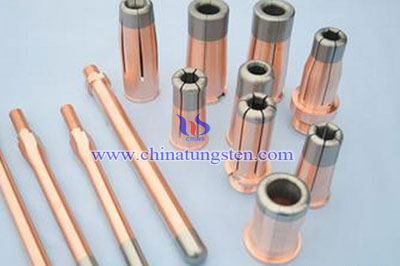Tungsten Copper Contact Defects and Solution
- Details
- Category: Tungsten Information
- Published on Friday, 03 June 2016 15:11
Copper infiltration is one of the most common forms of consolidation molding process, which is also an ideal molding process of tungsten-copper alloy melting point and a high melting point metal alloy two-phase psudoalloy composite materials. Compared with conventional mixing sintering, it can effectively eliminate the pores and defects and not need the subsequent processing (forging, re-sintering) can achieve good densification. So it has a broad prospect in electrical contacts fabricating. Tungsten copper contacts have been widely used in high or extra high voltage electrical equipment, circuit breakers, switches. Its fabricating process includes powder mixing, pressing, sintering, infiltrating and solidification, and any defects of each process will directly affect the properties of tungsten copper contacts finally.
Copper enrichment: it is also known as copper pool or copper depression. The reason for this phenomenon is due to induced copper powder large in size has been added in the mixing process. And it is pressed to the strip, the strip leaving melted pores are filled with liquid copper infiltration; the other one is when the mixed powder into a large ball, ball or adding too much copper induction before mixing was pressed into a sheet, and pressing time and pressing a direction parallel.
Tungsten enrichment: W skeleton has certain strength and the interconnected pores or channel system consist of solid grains or grain net. If the sintering temperature is too high or the sintering time is too long, W particle sintering neck increasing the contact area between the particles is also increasing, the formation of isolated pores, making the latter the infiltration process can not effectively penetrate the copper solution, and the obturator is formed. Such contact in the arc process appears the dregs of the phenomenon, affecting the life of the contacts. Adding activated agent and adjusting the proper sintering temperature is the most effective solution.
In addition, viewed from the cross section parallel to the pressing direction, macroscopically visible tungsten-copper material sandwiched between bright copper, microscopically observed throughout the copper belt. The appearance of micro-cracks is due to the higher speed in pressurization, and the gas in the powder is too late to escape, which has elastic after-effect after pressure relief. Secondly because the powder contained in the organic solvent is not completely evaporated, after pressing the gas slowly volatilize lead to micro cracks. The appropriate solution is to slow down the speed of pressure and ensure a longer dwell time.

| Tungsten Copper Supplier: Chinatungsten Online tungsten-copper.com | Tel.: 86 592 5129696; Fax: 86 592 5129797;Email:sales@chinatungsten.com |
| Tungsten News & Prices, 3G Version: http://3g.chinatungsten.com | Molybdenum News & Molybdenum Price: http://news.molybdenum.com.cn |



 sales@chinatungsten.com
sales@chinatungsten.com